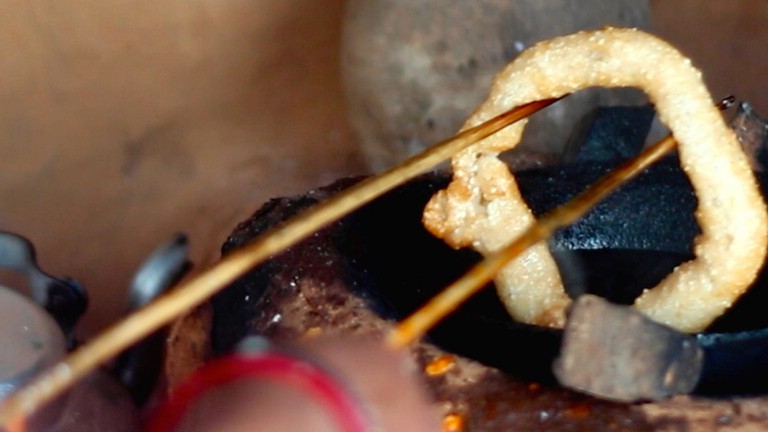 Ask any Nepali what their favourite food is and you’re likely to get a laugh and a ‘dal bhat, of course!’ While it’s imperative that you get used to eating dal and rice several times a week (if not, twice a day), there are plenty of other delicious traditional Nepali dishes that you should try while in Nepal. Here are our favourites.
Ask any Nepali what their favourite food is and you’re likely to get a laugh and a ‘dal bhat, of course!’ While it’s imperative that you get used to eating dal and rice several times a week (if not, twice a day), there are plenty of other delicious traditional Nepali dishes that you should try while in Nepal. Here are our favourites.
Sel roti

Sometimes called Nepal’s answer to the donut (because they’re deep-fried and round), sel roti are in fact much less sweet than the familiar donut, though they do have a hint of sweetness. They’re commonly found at road-side snack stalls and made in Nepali homes during celebrations and certain festivals (especially Maghe Sankranti and Tihar).
Gundruk
Wildly popular in Nepal, gundruk is made by fermenting leafy green vegetables. It’s commonly made into a pickle, called gundruk ko achar. It tastes like nothing else we can think of – slightly mushroomy and quite salty. It perfectly complements Nepali curries and a dollop of it is usually added to a dal bhat meal.
BaraBara

Newaris are a Nepali ethnic group who were the original inhabitants of the Kathmandu Valley. Their distinct culture, cuisine, architecture and language still have a strong presence in the capital. Newari food is a unique subset of Nepali cuisine. A popular Newari snack is bara (also spelled bada), which is kind of like a thick savoury rice-flour pancake. It can be eaten plain, with an egg cracked on top or with minced buffalo meat.
Chatamari
Chatamari is another favourite Newari snack that is very popular in Kathmandu. It has been called a ‘Nepali pizza’, but that’s only because it’s sort of round. Chatamari is a rice-flour crepe (thinner than bara) that is cooked with a variety of savoury toppings such as chopped onions, fresh coriander, minced meat, egg, chillis and a variety of spices.
Yomari

Yomari is such a special food that it has its own festival, usually celebrated in December, called Yomari Punhi. The Newari festival marks the end of the rice harvest and sweet yomari are made and eaten on this day. The pointed, fish-shaped dumplings are made from rice flour and stuffed either with a sweet molasses mixture or a coconut one. Either is delicious.
Aside from Newari households during the Yomari Punhi Festival, yomari are available year-round at The Village Cafe on Pulchowk in Patan and in the bakery section of the nearby Bhat Bhateni Supermarket. They are hard to find elsewhere, outside the festival time.
Chiura

Chiura is a bit of an acquired taste. It is rice that has been beaten flat and dried to keep it fresher for longer. It can be quite dry to eat, so it’s best as an accompaniment to very wet curries. Be warned that it swells up in the belly once eaten, so you can feel quite full after eating chiura!
Sandheko
This spicy Newari salad is usually made with potatoes or peanuts, as well as chillies (lots of them!), raw onions, fresh coriander, spices and is served cold. This very tasty dish is a popular bar snack.
Momos

While momos are usually called Tibetan dumplings, the truth is, they’re usually better in Nepal (take this from someone who’s tried them in both places!). They are a favourite among Nepalis, not only of Tibetan origin, so it’s safe to call them Nepali food. Rice paper wrappers are stuffed with finely chopped vegetables, minced buffalo or chicken and are steamed, deep fried or added to a spicy soup. They’re also served with large helpings of spicy pickles, for dunking. Momos are always hand-made fresh to order, so don’t be surprised if your order takes three times longer than everyone else’s to arrive.
Juju dhau
Juju dhau, or ‘king curd’, is a thick, creamy, sweetened yogurt served in clay pots in the city of Bhaktapur. It’s made with buffalo milk, so it’s much richer than regular cow’s milk yogurt. It’s an important accompaniment to many Newari celebrations and a must-try when visiting Bhaktapur. Grab a pot from a street-side vendor.
Dal bhat

Alright, we couldn’t present a list of traditional Nepali dishes without giving dal bhat an entry of its own! To call this rice and lentil dish a staple of Nepali cuisine would be an understatement – it’s so much more than just rice and lentils. When served in a restaurant or at home, the rice and lentil curry is accompanied by a variety of seasonable vegetable and meat curries (spinach, potato, mushroom, chicken, buffalo, etc), as well as a salad, pickles, papad and curd. It’s not just a dish, it’s a full meal and a tasty and satisfying one at that. It’s no wonder Nepalis are obsessed.


